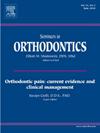颞下颌关节退化患者的开咬管理
IF 2.2
4区 医学
Q2 DENTISTRY, ORAL SURGERY & MEDICINE
引用次数: 0
摘要
开牙合咬合是一种多因素问题,对于正畸医生来说,这是一种具有挑战性的错颌畸形类型。认真细致的诊断对于确保正确的治疗方法非常重要。随着临时骨骼固定装置(TSADs)的使用,现在在大多数情况下,无需手术干预即可治疗这类错颌畸形。这种错颌畸形的形成涉及多种病因,包括患者的面部生长模式、持续的吸吮习惯、舌功能障碍以及因呼吸道受损而导致的口呼吸。这些因素应在患者生命的早期加以识别。治疗策略包括控制习惯、舌床和纠正任何气道问题,而对于更严重的开放性咬合患者,则需要进行正颌手术来纠正问题。现在,可以通过使用TSADs植入后牙来治疗。本文介绍了一种因髁突退化导致的开放性咬合。在过去,这种问题只能通过正颌手术来矫正。在这里,我们展示了通过使用 TSADs 插入后牙来治疗后天性开牙合的结果。此外,我们还提供了选择适合使用 TSADs 治疗的病例以及仍然需要正畸和正颌外科手术联合矫正的病例的指南。本文章由计算机程序翻译,如有差异,请以英文原文为准。
Management of open bite in patients with temporomandibular joint degeneration
Open bite is a multifactorial problem, which is a challenging type of malocclusion for the orthodontist to treat. A careful and detailed diagnosis is important to ensure the correct treatment approach. With the use of temporary skeletal anchorage devices (TSADs), it is now possible in most cases to treat these malocclusions without surgical intervention. Several etiological factors are involved in the development of this malocclusion, including the patient's facial growth pattern, persistent sucking habits, tongue dysfunction, and mouth breathing due to compromised airways. These factors should always be identified early in a patient's life. Treatment strategies have included habit control, tongue crib, and correction of any airway problems, while in the more severe open bite patients, orthognathic surgery was necessary to correct the problem. Now, it can be treated by the intrusion of the posterior teeth using TSADs. This article presents one type of open bite resulting from condylar degeneration. In the past, this problem could have only been corrected with orthognathic surgery. Here, we demonstrate the result of an acquired open bite treated by intruding the posterior teeth with TSADs. In addition, we provide guidelines for selecting those cases that lend themselves to treatment with TSADs and those where combined orthodontic and orthognathic surgical correction is still needed.
求助全文
通过发布文献求助,成功后即可免费获取论文全文。
去求助
来源期刊

Seminars in Orthodontics
DENTISTRY, ORAL SURGERY & MEDICINE-
CiteScore
2.20
自引率
4.80%
发文量
28
审稿时长
10 days
期刊介绍:
Each issue provides up-to-date, state-of-the-art information on a single topic in orthodontics. Readers are kept abreast of the latest innovations, research findings, clinical applications and clinical methods. Collection of the issues will provide invaluable reference material for present and future review.
 求助内容:
求助内容: 应助结果提醒方式:
应助结果提醒方式:


